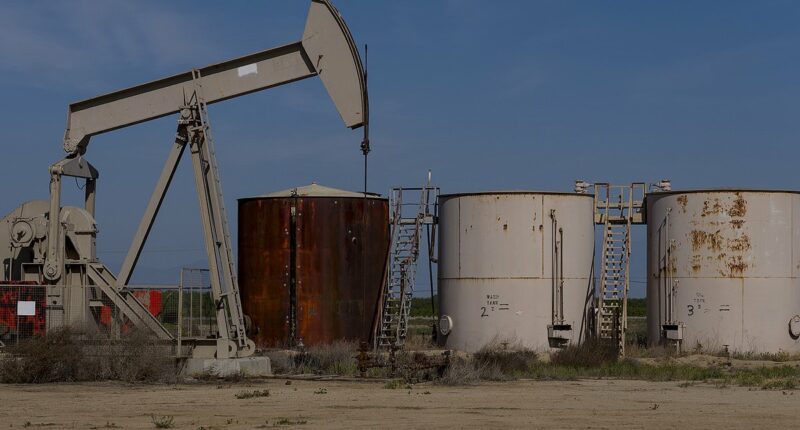Share this @internewscast.com
Thousands of Americans are living in the direct path of invisible toxic gas clouds from ‘super-emitter’ methane leaks across the country.
Researchers from the California-based non-profit science institute, PSE Healthy Energy, have developed a groundbreaking interactive map. This map utilizes data from over 1,300 significant methane leaks nationwide to project the distribution of hazardous air pollutants discharged during each incident.
Methane, a key component of natural gas, is a significant greenhouse gas. When it escapes from oil and gas infrastructure due to equipment issues, malfunctions, or ruptures, it serves as a carrier for various dangerous co-pollutants. These include substances known to cause cancer, such as benzene, toluene, ethylbenzene, and xylene.
The study revealed that approximately 127,000 Americans and over 100 sensitive sites, including schools and hospitals, lie within two miles of significant oil and gas leaks. This places vulnerable groups at risk from a hidden and harmful blend of pollutants, where exposure risks increase with higher concentrations and prolonged exposure.
Continuous exposure to this hazardous mix of chemicals is closely associated with leukemia, irreversible harm to the central nervous system, organ damage, and mental health issues. The initial leakage plume can last anywhere from a few minutes to several hours.
Benzene and other volatile organic compounds (VOCs) may infiltrate the soil or contaminate groundwater. From there, they can be released back into the air over extended periods, potentially persisting for years, and serving as a constant source of low-level indoor and outdoor air exposure.
New Mexico recorded the highest number of leak sites, with over 770 incidents. In nearly every case across the nation, levels of cancer-causing benzene surged beyond the state’s safety limits, endangering nearby residents, often without their awareness.
The EPA sets national methane standards; not a single number, but a framework requiring monitoring, leak repair, and zero-emission equipment. States must enforce these rules and may enact stricter ones. A key element is the ‘super emitter’ program, mandating immediate response to leaks exceeding 100 kg of methane per hour.

PSE Healthy Energy did not name specific plants or leak sites, just counties in which the sites are located. A Western Midstream natural gas facility located in Kern County, California is pictured. A July 2020 methane leak in this county exceeded 1,000 kg of methane per hour
Many super-emitter sites identified by PSE Health Energy have methane concentrations exceeding 300, 700 and 1,000 kg per hour. Bienville Parish, Louisiana, for instance, has a recorded concentration of 1,320kg per hour, while concentrations in Reagan County, Texas, exceed 3,500kg per hour.
Information on toxic chemicals released naturally during the extraction and transportation of fossil fuels and during accidental leaks is often scarce or difficult to access. To fill this gap, PSE Healthy Energy scientists undertook a sweeping effort to create their own database of chemicals found in oil and gas emissions.
They collected gas samples from wells across 11 of the nation’s top gas-producing states, including Colorado, Texas and Pennsylvania.
They also combed through thousands of air permit applications submitted by energy companies to federal and state regulators, compiling gas composition analyses.
The result was what scientists at the organization called the largest and most comprehensive database of its kind in the US, with data spanning from 2016 to 2025.
Methane emissions, they concluded, encompass a toxic soup of chemicals beyond just methane itself.
Nearly every sample contained a group of highly toxic volatile organic compounds known as BTEX, which stands for benzene, toluene, ethylbenzene and xylene, as well as hexane, which has been linked to central nervous system damage, permanent muscle atrophy and paralysis.
Long-term exposure to toluene can cause permanent brain damage that manifests as cognitive impairment, memory loss, poor concentration, and mood disorders. It also causes kidney and liver damage.

The map, which is interactive of PSE Healthy Energy’s website, shows that approximately 126,600 people and 110 sensitive facilities like schools and hospitals lie within two miles of methane ‘super emitter’ events
Inhaling high concentrations of ethylbenzene over prolonged periods can cause permanent damage to the inner ear, leading to hearing loss. It is also classified as a ‘likely’ human carcinogen due to its links to blood cancer.
Chronic exposure to xylene can lead to persistent headaches, dizziness, agitation, impaired short-term memory, and difficulty concentrating. Exposure to the pollutant has been linked to heart palpitations and an increased risk of heart disease
Almost all of the sites gave off amounts of benzene that health experts say can cause potentially severe health effects, including leukemia, a type of blood cancer, and fertility problems in men.
In Colorado, where 21 emission sites have been or are currently located, researchers found that children living near oil and gas wells had a significantly higher risk of developing leukemia.
Specifically, children aged two to nine living within 3.1 miles of high-activity gas-emitting sites were twice as likely to be diagnosed with leukemia compared to those not living near such operations.
Because methane has no color or smell, detecting leaks is nearly impossible without specialized tools.
Sofia Bisogno, an air quality scientist with PSE, told the Los Angeles Times: ‘That’s one of the most impactful things that I found from this. Any event that you see on this tool is likely not covered by local media sources because we don’t know that they exist. We don’t know that they’re happening.’
‘People are not made aware that these things are potentially impacting their communities, like this tank emitting right next to a bunch of residences,’ she added, pointing to a cloud of benzene spewing from an oil storage tank near a mobile home park in Weld County, Colorado.

Short-term, low-level chemical exposure can cause symptoms like dizziness or worsened asthma, while long-term exposure is linked to severe conditions like leukemia, organ damage, and permanent nervous system harm (stock)
The non-profit’s tool was developed in response to environmentalists’ concerns that deregulatory actions under the Trump administration would lead to an increase in methane pollution.
In February 2025, Congress scrapped a rule that would have charged big oil and gas companies for releasing excessive methane.
The plan, called the Waste Emissions Charge, would have started at $900 per ton in 2024 and risen to $1,500 per ton by 2026 as a financial penalty for extra emissions.
Methane, a greenhouse gas with 80 times the heat-trapping potency of carbon dioxide, is ALSO A major driver of climate change.
According to previous scientific research, emissions from the oil and gas sector are nearly triple the levels reported by the Environmental Protection Agency.
Kelsey Bilsback, principal investigator on the map, told Inside Climate News that the emissions events the team located represent a small fraction of methane emissions events happening across the country at any given time, adding that the map provides ‘a vast undercount of the number of people at risk.’
No death certificate in the US has ever listed air pollution as the cause of a person’s death, but researchers have tried to quantify the number of lives lost due to toxic emissions.
Researchers from Massachusetts Institute of Technology’s Laboratory for Aviation and the Environment measured harmful emissions at ground level from sources across the US, such as power plants, vehicles, ships, trains and heating systems in businesses and homes.
The research concluded that this pollution is responsible for roughly 200,000 premature deaths annually.
















